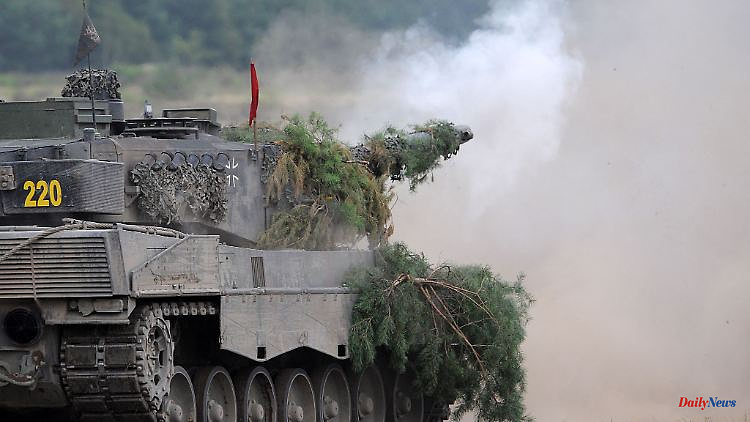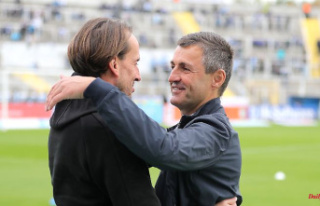Not only Kyiv, but also German armaments manufacturers such as KMW and Rheinmetall are cheering about Scholz' tank decision: it should secure billions in profits for the companies for years to come. Because Ukraine needs hundreds of German tanks.
Armin Papperger leaves no doubt that he is in the starting blocks for new orders. "The entire German industry is ready. The resources are there, the people are there, we also have the know-how," said the Rheinmetall boss exactly a week ago. "What we need now is solidarity with politicians that we have the ability to plan."
Shortly thereafter, Papperger got what he had wished for: after weeks of hesitation, Chancellor Olaf Scholz cleared the way for the delivery of Leopard tanks to the Ukraine that same evening. The decision was "right to the point," comments a stock trader. And logically, the Rheinmetall price immediately jumps to a new all-time high of almost 230 euros the next morning. Since Putin's attack on Ukraine on February 24, 2022, it has increased by 130 percent. The financial markets quickly sensed that the biggest upheaval in security policy since the Second World War also meant a quantum leap for the profits of the German armaments industry. From the 100 billion euro special fund for the Bundeswehr, which Papperger wants to tap into as quickly as possible, there has not yet been a single order for Rheinmetall and Co. on paper. But at the latest with the decision to deliver German tanks to Kyiv, the turning point should now be clearly reflected in the balance sheets of the weapon manufacturers.
Rheinmetall made sales of 6.4 billion euros last year - an increase of around 13 percent. By 2025, it should almost double to 11 to 12 billion euros. The lion's share of the business is in military equipment, including the Puma infantry fighting vehicle, military trucks and the Leopard 2, whose cannon, fire control system and ammunition are manufactured by Rheinmetall. "Our goal is a profit margin of at least ten percent before taxes," Papperger recently told "Stern" a few hours before the tank deal was published.
Like Rheinmetall, the Munich gunsmith Krauss-Maffei Wegmann (KMW), the main manufacturer of the Leopard 2, should also benefit from the planned tank alliance for the Ukraine. The KNDS group, to which the family business belongs together with the French tank manufacturer Nexter, had sales of 2.7 billion euros in 2021.
Whether and how loudly the coffers will ring at KMW and Rheinmetall depends on when and how many Leopards roll into Ukraine - and whether the donor countries place additional orders with the German armaments industry. Germany and Poland have already promised 14 units each. The Netherlands, Portugal, Spain, Norway, Denmark and even the NATO accession candidates Sweden and Finland have also signaled their willingness. Two whole battalions are supposed to come together like this.
So, in total, about 70 Leopard 2 tanks are more or less firmly promised to Ukraine. With a unit price of three to nine million euros for the older models, depending on the equipment, and 15 million euros for the latest version, the A7V, this would mean revenue of up to one billion euros for the manufacturer KMW alone. Rheinmetall could also benefit massively as the main supplier of the Leopard 2: Based on the previous ring exchange agreements with Slovakia and the Czech Republic, UBS expects a possible potential of up to ten million euros for modernization, ammunition and spare parts per tank. So a potential new business of up to 700 million euros.
A new business that should still require some patience. A modern combat machine like the Leopard 2 cannot be repaired in a month, let alone built. Because the tanks are needed immediately on the battlefield, the armies of the donor nations hand them over to Kyiv ready for action from their respective stocks instead of having the industry produce them for months. The previous delivery commitments do not automatically mean new sales for another reason: decisions about subsequent purchases or even concrete orders have not yet been made.
In the medium term, however, the promised Leopard tanks for KMW and Rheinmetall are likely to generate billions in sales over the years: If Germany and the other NATO countries don't bleed their own armies dry and thus risk their own defense capabilities, they will have little choice , than to reorder.
This is solely due to the sheer mass of tanks that Kyiv will need. Like Russia, Ukraine loses dozens of steel behemoths every month. Months ago, Ukraine's chief of staff was begging that he needed at least 300 modern Western tanks in order to be able to counter Russia's upcoming spring offensive in the long term. Especially since Russia can potentially mobilize up to 2000 tanks from old Soviet stocks.
With 14 leopards from Augustdorf it is therefore far from done. The brutal war of attrition in Ukraine will quickly push the western stocks currently available to their limits. Especially since operational Leopard tanks are already in short supply: the Czech Republic, for example, does not want to give up for the Ukraine and insists on the tanks promised by Germany as part of the ring exchange. "It is now not possible to send the Leopards on, because we need these tanks for our security," said the Czech Prime Minister at a meeting with Chancellor Olaf Scholz last week.
According to the International Institute of Strategic Studies, around 2,000 Leopard 2 tanks are in service with NATO countries in Europe. So there would be enough material for the permanent support of Ukraine. And thus also plenty of potential for supplies from the workshops of the German armaments industry.












